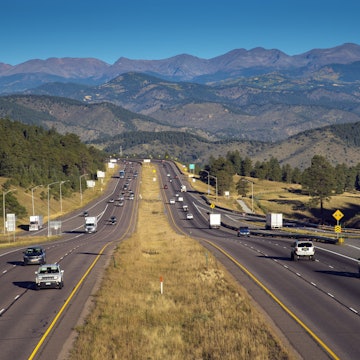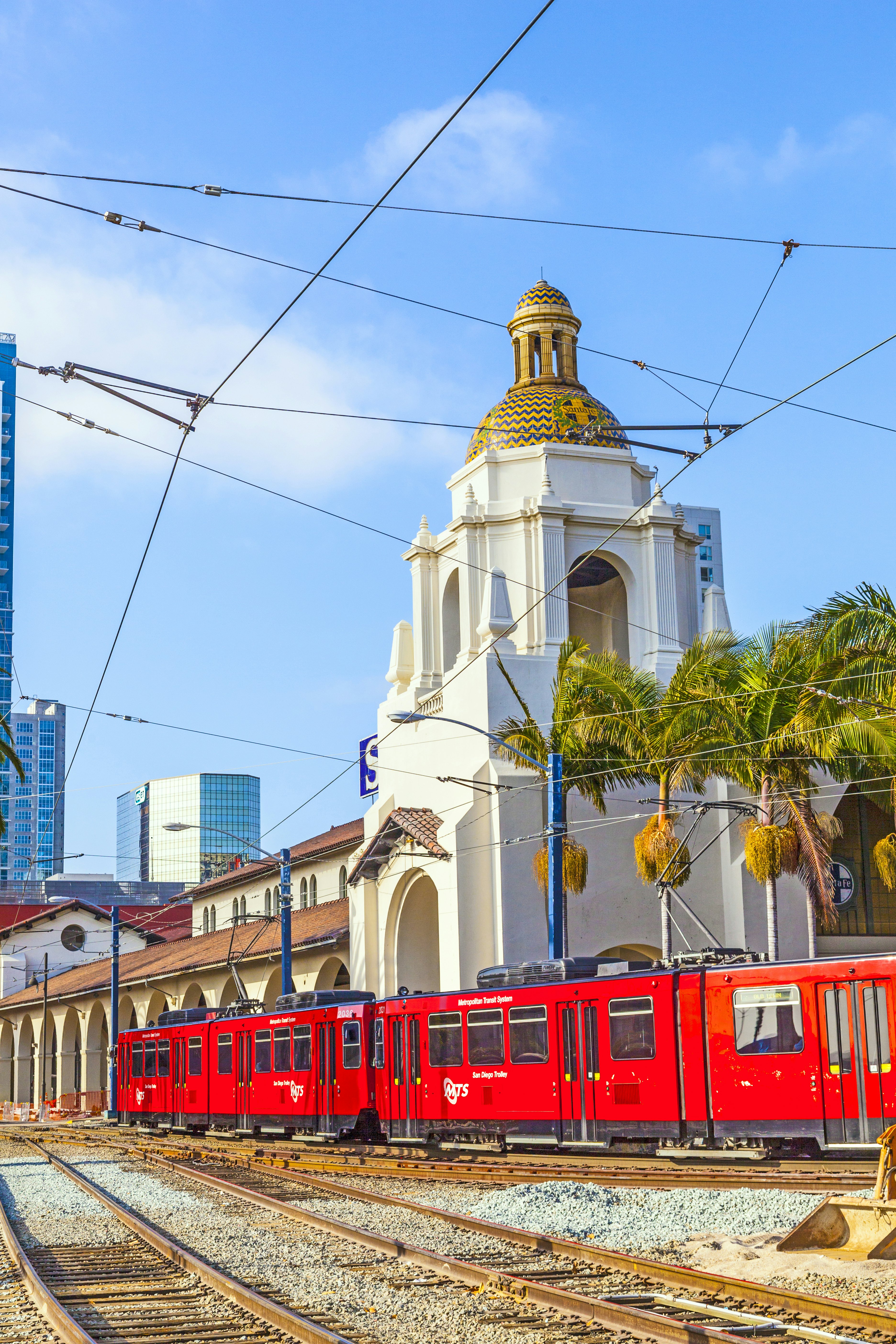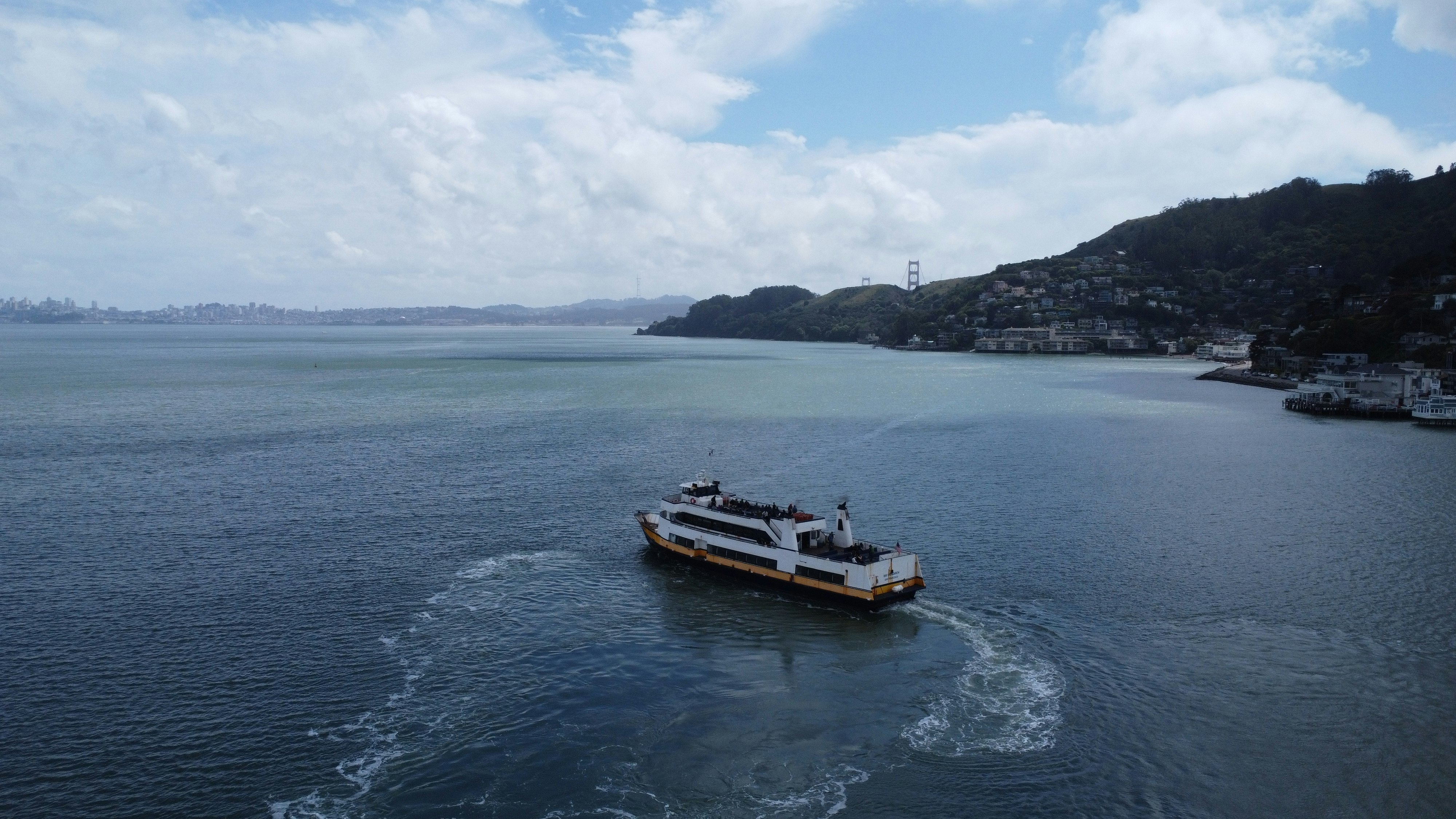
Everything you need to know about getting around California

Jul 10, 2025 • 10 min read

A road near Pioneertown, California. Jon Bilous/Shutterstock
It's become an iconic image of travel in the United States – a red convertible with the top down, cruising such classic California thoroughfares as the Pacific Coast Highway or across the Golden Gate Bridge.
California seems synonymous with cars – and rentals are readily available – but you can easily get around without touching a steering wheel using the many plane, train, bus and public transportation options. Here's how to find your way around in the Golden State.
Flights save time and are priced competitively
Major airports in Southern California are Los Angeles International Airport, Hollywood Burbank Airport and San Diego International Airport. In Northern California, the major airports are San Francisco International Airport, Oakland International Airport and San Jose International Airport in the Bay Area, and Sacramento International Airport in the Central Valley. There are numerous smaller regional airports throughout the state.
Alaska, American, Delta and United all offer service across California through mainline flights and their commuter affiliates. JetBlue and Southwest also have comprehensive networks of California flights. Avelo offers discount flights from its hub at Hollywood Burbank Airport to smaller California airports, including Charles M. Schulz Sonoma County Airport, which is ideal for the wine country.
The air corridor between the Bay Area’s airports and those in Southern California is one of the world’s busiest. With all the air service in the state, fares stay low and competitive. However, it’s worth remembering that getting between the two halves of the state by land can be more than half the fun of a visit, so only fly if you’re pressed for time. Skipping a flight in favor of a train or the bus is also much better for the environment.

Take the train to revel in California’s beauty
Amtrak operates a fairly extensive rail system in California. There are long-distance trains that connect the state with other parts of the US and regional trains, which provide more frequent local services.
Besides trains, Amtrak operates a network of Thruway buses that link certain train stations to popular destinations that lack direct train services, such as Santa Cruz, Carmel-Monterey and Yosemite National Park.
There are three networks of regional trains covering California
Amtrak has three local networks of trains in California that it operates with state and local transportation authorities. There are several trains daily on each of these routes. The double-deck coaches have large windows, snack bars and Wi-Fi. Fares are cheap and usually fixed, although it’s possible to use these networks as a connection to longer journeys on long-distance trains.
Capitol Corridor: This train links San Francisco’s East Bay (including Oakland, Emeryville and Berkeley) and San Jose with Davis and Sacramento several times daily. Thruway buses connect west to San Francisco, north to Auburn in the Gold Country and east to Truckee and Reno, Nevada. Transfer to BART trains in Richmond for fast connections to Berkeley, San Francisco and San Francisco International Airport.
San Joaquin: Running between Bakersfield and Fresno in the Central Valley and Oakland or Sacramento, the San Joaquin has Thruway bus connections to San Francisco, LA, Palm Springs and Yosemite National Park.
Pacific Surfliner: This is a busy network of trains that run from San Diego in the south via LA to as far north as San Luis Obispo. Many parts of the route feature superb coastal scenery. Stops include San Diego's North County beach towns; Orange County's San Juan Capistrano and Anaheim, home of Disneyland; and Burbank, Ventura, Carpinteria and lovely Santa Barbara.
In addition to Amtrak’s regional trains, there are two commuter train networks in California that are very useful to visitors: Caltrain in the Bay Area and Metro Rail in Southern California.
Some long-distance trains have useful stops in California
Amtrak has four routes that link California to other states, usually running once a day in each direction. Each one makes a few useful stops within California for people not traveling interstate. As always, the best fares sell out first.
California Zephyr: This is a spectacular journey through the Sierras that follows the route of the original transcontinental railroad in California, Nevada and Utah. Stops in California include Sacramento and Auburn.

Coast Starlight: One of the world’s most beautiful train rides, between the Bay Area and LA, the Coast Starlight lives up to its name by running along some stunning stretches right on the ocean. Tickets can include a bus connection into downtown San Francisco from the stop in Emeryville. Other California stops include Redding, Sacramento, San Jose, Salinas, San Luis Obispo and Santa Barbara.
Southwest Chief: Following the route of the famous Super Chief, a train that traveled between Los Angeles and Chicago in the glory days of rail travel in the 1930s and 1940s, the Southwest Chief's daily run passes through the Mojave Desert. Californian stops include Barstow and Needles.
Sunset Limited: Running close to the Mexican border three times weekly, linking LA and New Orleans, this train can get you to Palm Springs.
Save money and take the long-distance bus
Besides Amtrak’s highly useful Thruway buses, Greyhound operates buses over longer distances that generally follow the major interstate highways as well as Hwy 101 between San Francisco and Los Angeles. Flixbus also operates regional buses around the state. Buses offer Wi-Fi, charging points, and on-board restrooms.

Public transportation is reliable in cities and towns
Almost all cities and larger towns in California have reliable local bus systems (average $1.50 to $3 per ride). Buses are usually the cheapest and slowest option, but you'll typically find extensive metro-area networks around big cities. In San Diego, for example, municipal trolleys operate on three lines as far south as the Mexican border.
A few cities and regions have trains and light rail as part of their public transit offerings.
Northern California Caltrain runs high-frequency commuter trains from San Francisco south along the Peninsula via Palo Alto and Mountain View to San Jose and on to Gilroy. BART (Bay Area Rapid Transit) is a fast network of trains that link San Francisco with cities across the East Bay including Oakland and Berkeley as well as the airports in San Francisco and Oakland.
Southern California Metrolink is a sprawling network of seven commuter rail lines that fan out from Los Angeles. Stops of interest to visitors include Burbank’s airport and Anaheim in Orange County for Disneyland. The related Metro network includes two subway lines, four light-rail lines and a variety of bus lines. Major stops are Hollywood, Santa Monica, Venice and LAX.
Find your way with 511.org
511.org is an essential state-funded service with information on all things transportation-related in California. It has a website, apps and a phone service you can use to get details on anything from road conditions to bus and train schedules.
A rental car gives flexibility but also comes with challenges
California’s love affair with cars runs deep for at least one practical reason: the state is so big that you’ll want the convenience and flexibility of your own wheels if you want to see a lot of it. Certainly, this applies to some of California’s top sights such as the Pacific Coast Highway (Hwy 1) along the coast between the Oregon border and Southern California as well as many of the beautiful mountain roads across the Sierras, the deserts and the far north.
Then again, when you’re staying in San Francisco, the last thing you’ll want is to be saddled with the myriad hassles of a vehicle.
To rent your own wheels, you’ll typically need to be at least 25 years old, hold a valid driver’s license, and have a major credit card (not a debit or ATM card). A few companies may rent to drivers aged over 21 but under 25, but there will likely be a hefty surcharge.
Car rental rates can be high, even for a generic subcompact. If you want to go green with a hybrid or electric car, you will pay extra for it. And if you have to ask the price of a convertible so you can live the fantasy of cruising Hwy 1 with the top down, then you can’t afford it.
When comparing rates, it’s always worth checking what’s on offer from small indie outfits, even if reaching the rental lot requires a long ride on a shuttle bus.
Your driver's license from home allows you to drive in California for a year
Visitors may legally drive a car in California for up to 12 months with their home driver’s license. If you’re from overseas, an International Driving Permit (IDP) will have more credibility with traffic police and simplify the car-rental process, especially if your license doesn’t have a photo or isn’t written in English.
To ride a motorcycle, you’ll need a valid US state motorcycle license or a specially endorsed IDP. International automobile associations can issue IDPs, valid for one year, for a fee. Always carry your home license together with the IDP.
You will need liability insurance
California law requires liability insurance for all vehicles. When renting a car, check your auto insurance policy from home or your travel insurance policy to see if you’re already covered. If not, expect to pay $10 to $30 per day for an insurance package.
It’s always worth checking to see if your auto insurance policy at home or your credit card provides insurance coverage so you can avoid the rental agency’s pricey policy.
Parking in California cities can be tricky and costly
Parking is usually plentiful and free in small towns and rural areas, but often scarce and/or expensive in cities. When parking on the street, read all posted regulations and restrictions. Pay attention to colored curbs, or you may be ticketed and towed.
Municipal parking meters and sidewalk pay stations may take coins, credit cards and/or payment via apps. Downtown and hotel parking garages in San Francisco and LA can cost $30 to $50 per day.

RVs are expensive to rent but save you money in other ways
Long a standby of family summer vacations and retirees in the US, recreational vehicles might be expensive to rent, but they combine transportation, accommodation and cooking needs in one fell swoop.
It’s easy to find RV campgrounds across California with electricity and water hookups. What’s not easy to do is find a reservation to camp at one of the more sought-after state and national parks due to surging popularity. Your ability to roam at will, stopping where the spirit moves you, will be dependent on how many others have the same idea. You may need to lock in much of your trip by booking camping reservations months in advance. However, if you’re willing to go to more obscure corners of the Golden State, you might just enjoy total roaming freedom.
Book RVs as far in advance as possible. Rental costs vary by size and model, but you can expect to pay more than $100 per day. Rates often don’t include mileage, bedding or kitchen kits, vehicle-prep fees or taxes. If pets are allowed, a surcharge may apply.
Also note that California’s homeless crisis has many people living in older RVs parked along the streets in urban areas. There are laws that discourage this, which can affect the unsuspecting visitor looking for a place to park for the night.
Taxis are available throughout California
Taxis and ride-hailing services like Uber and Lyft can be found throughout the state. Rates are not inexpensive.
Sail between ports on a ferry

Boats won’t get you around California, although there are a few offshore routes, notably to Catalina Island off the coast of Los Angeles and Orange County, and to Channel Islands National Park from Ventura or Oxnard, northwest of LA heading toward Santa Barbara. On San Francisco Bay, a comprehensive ferry network operates between San Francisco and Sausalito, Larkspur, Tiburon, Angel Island, Oakland, Alameda and Vallejo. The views from these boats are fabulous.
Accessible transportation in California
California is reasonably well-equipped for travelers with disabilities. Most intersections have dropped curbs, and some have audible signals for people crossing the streets.
The Americans with Disabilities Act (ADA) requires public buildings, including airports, train stations, bus stops and restrooms built after 1993 to be wheelchair-accessible. Motels and hotels built after 1993 must have at least one ADA-compliant accessible room; state your specific needs when making reservations.
Most national and many California state parks and other outdoor recreation areas offer paved or boardwalk-style nature trails accessible to wheelchairs.
For longer distances, all airlines, trains and buses can accommodate people with disabilities, although there may be a requirement for 48 hours advance notice. Public transportation networks have buses, trams and trains that are accessible without advance notice. Legitimate service animals can accompany their owners on all forms of transport. For information on accessible public transportation in California, use the 511.org service.
Major car-rental agencies offer hand-controlled vehicles and vans with wheelchair lifts, but you must reserve these well in advance.















